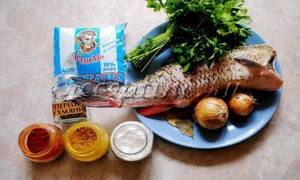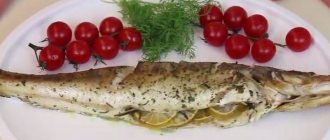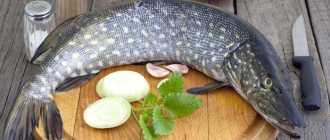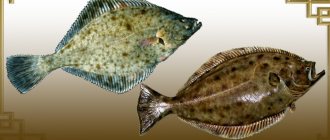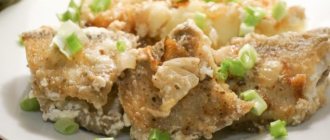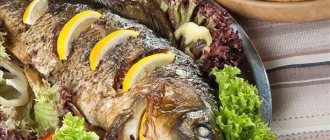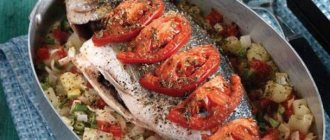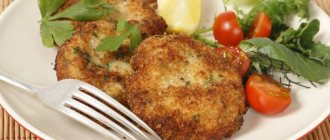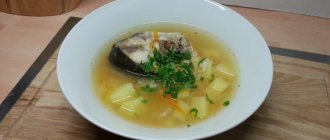Chub recipes
Today in cooking there are many ways to process fish; it can be used to prepare boiled, fried, dried, smoked dishes, as well as baked in the oven and used to make cutlets, as well as canned food. However, not every recipe can be called truly successful, and the dish is tasty and capable of surprising even inexperienced lovers of fish delicacies. Below are the most popular ways to cook chub at home, and also describe how to prepare the product with maximum health benefits.
Chub in the oven with potatoes
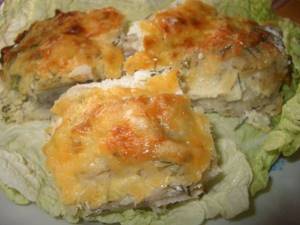
There are several ways to get rid of the characteristic odor:
- Rub the prepared carcasses with salt and wait 15 minutes;
- mix lemon juice, squeezed garlic and salt and grate the fish;
To deliciously cook chub in the oven, you need to take the following products:
- fresh fish carcasses – 1 kg;
- onions – 2 pcs.;
- potatoes – 1.2 kg;
- egg – 1 pc.;
- cream – 1 tbsp;
- herbs, dill, spices.
For this recipe, the heads are not cut off, only the gills are removed. Then:
- in a washed and dried carcass, shallow cuts are made on the sides to cut small bones;
- rub with herbs and spices;
- vegetables are cut into circles;
- make a potato pillow in a greased form and salt it;
- put a chub, inside - sprigs of dill, on top - circles or onion rings;
- bake in an oven heated to 190 degrees until browned;
- The eggs are mixed with cream, lightly salted, the contents of the mold are poured in and baked for another 7-8 minutes.
The finished dish is served directly in the form. Separately, they offer salad or sliced vegetables (tomatoes, cucumbers).
Hot smoked chub without smokehouse
If there is no smokehouse, you can get out of the situation using available materials.
A deep pan will serve as a smoking apparatus. The bottom is covered with a thin layer of sawdust. If they are not at hand, then they make do with thin, dry branches of fruit trees. Do not use pine or spruce branches.
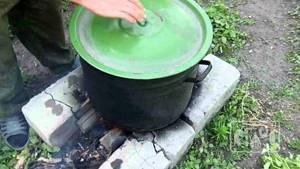
Smokehouse from a pan
Several pebbles of the same size are placed on top of the shavings. They will make a great base for a pallet. Its role is played by an ordinary plate. A grid of suitable dimensions is installed at a height of 4 cm from the pallet. It should not fall through and is placed so that the pan can be easily closed with a lid.
Prepared chub carcasses are laid out on a wire rack, lightly greased with sunflower oil. The fish is placed in one layer and the distance between the carcasses is maintained at least 2 cm. If the depth of the pan allows, you can install another grill.
The improvised smokehouse is closed with a lid and sent to the fire. As soon as smoke appears, time is noted and the fire is reduced. Smoking time ranges from 20 to 60 minutes. If you like drier fish, increase the time.
Raise the lid several times during the entire smoking process. At this time, steam is released, which greatly softens the chub carcasses.
In large individuals, special spacers are installed in the abdominal area. This ensures better smoking. Experienced smokers advise dividing large carcasses into equal pieces.
Chub royally
So, we prepare the chub royally as follows. We take a fish, clean it of entrails and scales. We cut off the tail and fins, but do not touch the head. Personally, I think the head is the most delicious part of any fish.

- Pour lemon juice over the cut fish, sprinkle with salt and ground black pepper. After this, leave for 30-40 minutes in the refrigerator so that the chub marinates. After this time, we wash the chub under running water, pat it dry with a towel and cut it into portions.
- At the next stage of cooking, heat the vegetable oil in a frying pan, to which you should add a little butter. This will make the fish meat less lean. Throw pieces of chub into boiling oil. The fire must be very strong. The goal is to sear the fish superficially, but not cook it until it's done.
- Having taken the chub pieces out of the frying pan, put them in a fireproof container. Fill all this beauty with cream on top. It is advisable to use cream with the highest fat content. After this, place the container with the fish in the preheated oven.
- Turn on low heat and leave the chub in the oven for one and a half to two hours. Slow simmering over low heat will make the small chub bones completely unnoticeable. Lean meat will be soaked in heavy cream and take on a completely different taste.
I assure you that when you try this dish, you will not regret the time spent preparing it.
Chub recipes
Buy quality products at affordable prices in the best fishing online stores
. Give gifts to yourself and your loved ones!
we are in social networks
– follow us on , , and Instagram. Stay up to date with the latest site news.
What can you cook from chub? From a culinary point of view, chub is considered not a very pleasant fish due to the abundance of small bones. They are very difficult to choose from fish and are easy to miss and choke on. Therefore, chub pieces should be given to children with great caution.
In terms of nutritional properties, the chub is a valuable fish with tasty dietary meat. Due to the content of fatty acids, its meat is not as dry as that of white bream, for example. Chub dishes taste quite pleasant. Its scales are easily removed; the fins are somewhat more difficult to cut off.
An obvious disadvantage of this predatory fish is the specific smell of mud. Because of this, many cooks do not like chubs. Although the smell is easily eliminated by soaking the carcasses in a decoction of herbs, in milk, lemon juice, vinegar, or simply in salted water.
Chub dishes
What is the chub good for? Of course, royal dishes are not prepared from it; the value of the fish is not the same. But several dozen delicious chub dishes will please everyone who tries them for the first time.
Fans of dried fish enjoy drying small chubs. If desired, you can smoke them and within an hour you will get a fish that smells pleasantly of aromatic smoke.
The most common and simplest option for preparing river fish is frying whole carcasses or cut into pieces in a frying pan. In addition to a regular frying pan, the fish is fried on the grill and on a grill, and buried in the coals.
Chub dishes are very easy to prepare in the oven, after marinating and stuffing the carcasses with herbs, vegetables, and porridge. Or bake with a variety of sauces. If you first wrap the fish in foil so that the fish juice does not leak out, it will not dry out and will remain juicy.
Recipes for cooking chub with photos
Below is a list of the best recipes available on our site. Having chosen the option you like, you need to click on the name and go to a page with a detailed description of the cooking methods.
Browse and choose what you want to cook from chubs.
Fried chub
How to fry a chub without the unpleasant small bones? Use these tips and prepare simple chub dishes:
- Quick deep-fried pieces of fish in batter and without batter.
- Chub marinated with lemon juice, fried in cream.
- With sweet peppers and spices, roasted in the coals of a fire.
Chub in foil
Recipes for cooking chub with photos:
- Fish with vegetables under a hard cheese crust,
- Chub baked in cream with wine and spices.
The second recipe takes longer to prepare - about two hours, including the process of marinating fish carcasses in wine.
Chub in the oven
Cooking fish crusted with cheese. Main ingredients:
- Russian cheese - 200 grams for every kilogram of fish,
- half a lemon, cut into thin rings,
- mayonnaise - 1 package for applying a mesh to the fish and for the sauce,
- foil for spreading on a leaf and wrapping the fish on top.
Chub soup
Three recipes for making chub soup with photos. All recipes are simple, made from ordinary ingredients, and require no more than an hour to prepare:
- Fish soup with vegetables: onions, carrots, tomatoes, sweet peppers.
- Making creamy fish soup with semolina and vegetables.
- Cooking fish soup, which smells strongly of mud, with the addition of vodka.
Dried chub
Two methods of salting fish are described: from salt alone and from a mixture of salt with sugar, ground coriander and crushed bay leaves. Getting rid of excess salt is by soaking and washing the fish. The drying process with a description of all the rules - hanging, protection from insects. The minimum preparation time is 5–7 days.
Hot smoked chub
Options for smoking fish in a smoking cabinet and on a regular stove. A high-speed recipe for hot smoking chub is described - salting and drying the fish does not last long, about an hour. Tips are given on how best to prepare hot smoked chub. Here is a recipe for hot smoking chub without a smokehouse, in a regular saucepan with a stand.
This page presents the chub fish. Recipes for cooking chub with photos and all culinary recipes for other river fish can be found in the “Fisherman’s Kitchen” section.
All about chub fish:
Good fishing online stores
will allow you to purchase any fishing goods at competitive prices!
Follow us on social networks
– through them we publish a lot of interesting information, photos and videos.
Popular sections of the site:
The fisherman's calendar will allow you to understand how all the fish bite depending on the time of year and month.
The fishing gear page will tell you about many popular gear and devices for fishing.
Fishing baits – we describe in detail live, plant, artificial and unusual ones.
In the bait article you will get acquainted with the main types, as well as tactics for using them.
Learn all the fishing lures to become a real fisherman and learn how to choose the right one.
Source: https://ribalka-vsem.ru/index/recepty_prigotovlenija_golavlja/0-1234
Rich soup of heads
The more heads, the richer the broth will be. In addition to them, for the fish soup you will need to take:
- 2-3 potatoes;
- 1 carrot;
- 1 onion;
- 2-3 boiled eggs;
- bay leaf, pepper, dill, salt.
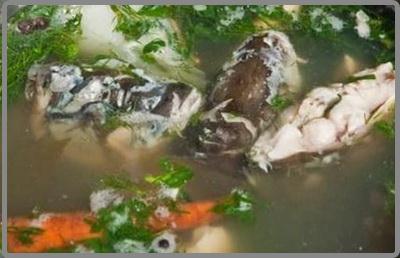
Preparation:
Heads without gills, onions and carrots cut into 4 pieces are poured with water, quickly brought to a boil and then cooked over moderate heat for 25 minutes. Before boiling, remove the foam and add spices, except dill. After the specified time, strain the broth and cook the chopped potatoes in it. Grate the carrots and eggs on a coarse grater and place them in the fish soup 3-4 minutes before they are ready.
Sprinkle the chub soup with chopped dill and serve in portions in bowls, the heads separately on a flat plate.
Cutlets
Appetizing and juicy fish cutlets should be prepared from the following products: 1 kg fillet, 200 g raw lard, egg, 200 g stale white bread, a pinch of extra salt, powdered pepper mixture, dried herbs for fish, 3-4 tbsp. l. clarified butter, 1/3 milk for soaking, 3 tbsp. l. flour.
Method for preparing the most tender chub dish: Remove the maximum number of large bones from the fillet and cut the meat into pieces. Pass the fish 2-3 times through a fine mesh grinder with a fine mesh, each time rinsing the shaft to remove any bones. Also swirl the lard and white bread soaked in milk.
Sprinkle the mixture with pepper, seasonings and salt. Release the egg and mix the minced meat. With damp hands, form even cutlets, roll in flour and fry in hot oil until crispy golden brown. Present a treat with French fries and sliced fresh vegetables and herbs.
In a slow cooker with sour cream
A simple and delicate treat suitable for daily and special occasions. It only takes 40 minutes to prepare.
Components:
- a couple of fillets,
- onion head,
- 2 tbsp. l. refined oil,
- 3 cloves of garlic,
- a pair of laurel trees,
- dill greens - a bunch,
- coarsely ground salt and crushed pepper - optional.
For the sauce:
- 300 m meat broth,
- a glass of low-fat sour cream.
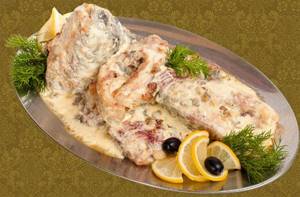
You can bake a delicious chub according to the following scheme:
- Cut the fillet with diamond-shaped cuts, being careful not to cut the skin.
- Chop the onion into cubes, also chop the garlic.
- In the multicooker, select the “Frying” program and pour a little oil into the bottom of the bowl.
- Fry the onion and garlic a little until golden. Season the fillet with salt and pepper and fry in a multicooker bowl for 3-4 minutes.
- For the sauce, combine sour cream with broth and bay leaf. Pour the mixture over the chub and simmer for 5 minutes on the “Stew” program.
- Serve fillet with sauce and salad mix. For fish, it is customary to use white pepper, lemon, garlic salt and rosemary with thyme
With champignons
The combination of soft fish meat with the aroma of rich mushrooms provides a delicious and light treat for the whole family. Ingredients: 1 peeled chub carcass, 300 g champignons, large onion, 2 tbsp. l. clarified butter, ½ glass of dry white wine, a bunch of fresh parsley, ½ stick of butter, coarse salt and pepper - as needed.
Required algorithm of actions: Wash and peel the meat, divide the champignons in half, and chop the onion into pieces. Rub the carcass with salt and spices and set aside for half an hour to marinate. Stuff with chopped herbs and place in a heatproof baking dish.
Fry the onion in hot oil until transparent, add the mushroom pieces and fry for another 5 minutes. Pour in the wine and simmer until it evaporates. Season the sauce and place in a baking dish with the fish. Sprinkle the workpiece with melted butter and place in the oven for 30 minutes at 180 degrees. Serve garnished with parsley.
Noble salmon is so tasty that it simply melts in your mouth. According to the proposed recipe, you can prepare a lightly salted treat with a delicate taste from a budget chub. Food set for cooking: 1 kg of fish, 2 tbsp. l. coarse salt, 1 tbsp. l. granulated sugar, pepper and coriander grains crushed in a mortar - optional, a couple of bay leaves.
Aromatic lightly salted fish can be prepared according to the following procedure: Open the fish carcass from the back along the entire length, cut off the head and tail, remove the entrails, remove the fins. The spine is cut out and the rib bones are pulled out. Prepare a mixture of spices for salting and coat the fish with the mixture. Fold the carcasses sideways and place them in a pan under pressure. Place the workpiece in the cellar and leave for 2 days. In color and consistency, the chub becomes similar to salmon, while small bones dissolve in the fibers.
Fried chub (in a frying pan)

Compound:
- chub – 1 kg (carcasses weighing 150-250 g);
- lemon juice – 20 ml;
- refined vegetable oil – 40-60 ml;
- butter – 20-30 g;
- flour or breadcrumbs – 80 g;
- salt, ground black pepper - to taste.
Cooking method:
- Clean the fish, gut it, rinse it well, and dry it with a napkin. Remove gills and fins. Make diagonal cuts on the carcasses (on the sides near the back). Rub the carcasses with salt and pepper, pour over lemon juice, and leave to marinate for 30 minutes.
- Sift the flour and place it on a flat plate. Breaded fish carcasses in it.
- Melt butter in a frying pan, add vegetable oil to it.
- Place fish carcasses in a frying pan and fry them on both sides until an appetizing crust. You need to fry over medium heat without a lid, periodically turning the fish carcasses with a spatula so that they do not burn.
Read more: Mackerel in the microwave - step-by-step recipe with photos
If your prey is a large fish, it is advisable to fry it by cutting it into pieces. The principles and technology of preparation will not change.
Frying in oil
This type of fish is considered dry and bony; the meat of large specimens smells like mud, so before frying, the fish should be properly cleaned and marinated. Food set: chub – 1.5 kg, clarified butter – 1/3 cup, a slice of butter – 50 g, wheat flour for breading – 100 g, 1 tbsp. l. lemon juice, coarse sea salt and ground pepper - to taste.
Fried chub will turn out very tasty if you follow these steps: Cut off the fins from the carcass, remove scales, gills and entrails. Place the cleaned carcass in salted water, pour in 1 tbsp. l. lemon juice and leave for 1.5 hours. Remove, rinse, dry the fish and cut into portioned steaks about 2-3 fingers thick. Bread the slices in flour and fry until crispy bronze in hot oil combined with butter.
Sufficient frying time is 5 minutes on each side. During the frying process, the slices will not dry out, and small bones in the meat will dissolve due to the temperature. Complete the presentation with mashed potatoes or broccoli, a slice of lemon or pickled green peas.
In beer
- Cut the delicious gutted and washed chub into portions, place in layers in a saucepan, sprinkle with chopped onions, grated carrots and tomato pulp without seeds and skins.
- Season with peppercorns, bay leaf, a pinch of coarse salt and granulated sugar.
- Pour ½ cup of vegetable oil onto 1 kg of fish and enough filtered beer to cover the fish with liquid.
- Also add a glass of sour cream to the preparation and simmer until done.
Serve the prepared treat with chopped herbs and shavings of hard cheese
Chub cutlets
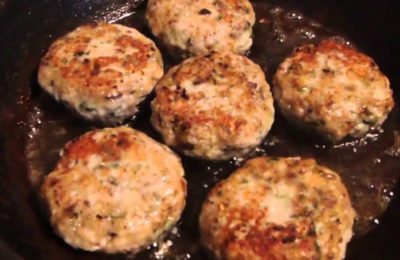
Compound:
- chub fillet – 1.5 kg;
- chicken egg – 1 pc.;
- lard (raw) – 0.2 kg;
- stale white bread crumb (without crusts) – 150 g;
- milk – 120 ml;
- onions – 100 g;
- salt, seasonings - to taste;
- flour, refined vegetable oil - how much will be needed.
Cooking method:
- After cleaning and gutting the chub, cut it into fillets. Rinse the fish fillet, pat dry with a napkin, and cut into pieces. Pass through the meat grinder twice, using the attachment with the smallest holes.
- Crumble the bread into a bowl and pour warm milk over it. After 10 minutes, squeeze out.
- Peel the onions and cut the middles into cubes.
- Grind the onion and bread through a meat grinder, combine with minced fish, and mix.
- Break an egg into a container with minced meat, add salt and spices. Knead the minced meat. Beat it on the board to make it more dense.
- Form cutlets from the resulting minced meat and roll them in flour.
- Heat the oil in a frying pan, place the cutlets in it, fry them on both sides.
If you want the chub cutlets to be more juicy, you can pour a couple of tablespoons of water or broth into the frying pan and simmer the products for 5-10 minutes.
What is fish balyk
Everyone knows what fish balyk is, but few have tried this delicacy. This is an expensive product. But its benefits and taste are at a high level, so many people strive to prepare the dish at home. Whatever cooking method is chosen, it is important to know the nuances of the technology, as well as the rules for choosing fish.
Delicious food with a rich history
The history of the origin of fish balyk
The concept of balyk comes from the Turkic language and originally meant dried fish fillet. In Europe, people learned about this dish in the 18th century, when international trade began to actively develop. But in European countries they began to use pork, beef and chicken for cooking. Nowadays, dried products continue to decorate tables, but fish balyk remains the most valuable.
Fish balyk is a dried product. Meat from the ridge zone is pre-salted using a special technology, and then left for a long time to air. This allows the meat to soak in the spices and dry out. It acquires a unique aroma and taste.
Fish balyk at home
You can prepare fish balyk at home, and you can be 100% sure of the quality of the dish. Before you begin the procedure, you should decide which fish to choose and which recipe to follow in order to get a satisfactory result. Each method has its own characteristics.
At the same time, a certain technology is typical for preparing the dish, which includes:
- preparation of fillets;
- pickling;
- drying.
Smoking is sometimes used to make the balyk more flavorful.
How to properly clean and cut a carcass
It is necessary to make balyk from fish at home, strictly following the technology, since an incorrectly prepared product can be hazardous to health due to the presence of pathogens. Initially, a thorough cleaning is performed: the scales are removed and the insides are taken out. It is also necessary to trim the fins.
There are several rules for individuals of different sizes:
- very large carcasses are cut along the ridge, divided into halves, and then additionally cut into pieces;
- large fish, after removing the entrails, is cut along the ridge into two equal parts;
- not very large carcasses are also cut along the ridge, but the belly is not ripped open and the head is not cut off. It is enough just to remove the gills.
If you need to speed up the salting time, you can further clean the skin.
What ingredients are needed
Balyk from fish can be prepared with a minimum set of ingredients: sugar, salt and seasonings to taste. The product is marinated in this mixture.
If salting in brine is required, then these ingredients are diluted with water. You can also add spices and gourmet seasonings for a richer flavor.
Pickling methods
You can marinate fish balyk in two ways:
- Dry salting involves rubbing prepared meat with spices. To do this, use salt and spices for fish. You can use a special seasoning or make it yourself. Before rubbing, mix the seasoning for salting with sugar and place the finished fish fillet in the refrigerator. The duration of this marinating varies. For example, about 1 week is needed to obtain salted balyk, and for lightly salted balyk, 4 days will be enough. Small fish, for example, asp, mackerel, can be placed in the refrigerator for a day.
- Marinating in brine. This will require 4 liters. Water. The amount of salt will depend on the weight of the fish. So, for a silver carp weighing 7 kg. you need to take 385 gr. salt. Water with spices is boiled and then cooled. Fill the fillet with brine and place it in the refrigerator for 4-6 days. After this, you need to soak the meat well so that excess salt is removed from the product.
If dry salting is used, it is better to put the fillet under pressure, wait for the specified time and rinse thoroughly.
Heaviness allows you to effectively remove moisture from the meat along with all the harmful substances present in the fish. Regardless of how balyk is prepared, the main stages are similar and salting is considered one of the most important, because taste qualities largely depend on the quality of this procedure.
How to dry fish correctly
Drying requires certain conditions - light, heat, air circulation. It is important to choose the right period. It’s too hot in summer, so it’s important to hide the fish from direct sunlight and provide ventilation. Spring is considered the best time.
Homemade balyk cooked at this time will have the perfect aroma and taste.
The fattest meat occurs in the fall, so if you organize the conditions correctly, you can dry the product at this time. But in winter it is unlikely that you will be able to get a good result, since humidity and air temperature do not allow the meat to dry out slowly, and placing it indoors will lead to the usual drying out of the meat.
Features of cooking from different breeds of fish
The basic principles for preparing red and white fish are no different. The duration of drying and the set of spices used may differ. In any case, the taste of balyk from any type of fish will be original and bright.
White fish balyk
It is not always possible to find large white fish. Plus, it's not as greasy as red. Mackerel is considered the best option. If you need a large fillet, you can take catfish. Weight from 3 kg. This type is easy to find. It will surprise you in terms of taste.
A common option is dried carp meat.
Balyk prepared from such fish is fatty, especially if you take carcasses caught in the autumn. Fish over 5 kg are best suited.
They must first be cleaned, the fins trimmed, and the ridge removed. Now cut the carp into portions, but not too small so that it is convenient to dry them.
This procedure should be done with any large fish, as it speeds up the drying process.
A special feature of preparing white fish at home is salting. It is better to use additional spices for it, which will not only enhance the taste and aroma, but also give the product a beautiful color. Often for this purpose, balyk is smoked. This is not necessary, since the taste of the dish will be exquisite without it.
Red fish balyk
Balyk made from red fish is considered traditional. Most often, salmon, trout, salmon, and sturgeon are used for cooking.
Fatty meat turns out so tasty and aromatic that there is no need to use additional spices for marinating. Just salt and sugar will be enough. The carcasses are usually large, so attention should be paid to butchering and cutting into ideal pieces for salting.
Cooking tips from chefs
Before you make a masterpiece, you should choose a suitable fish balyk recipe and strictly follow the technology. But in order to get a result that will exceed expectations, you should listen to the recommendations of professionals:
- If fish balyk is prepared in the summer, it is better to extend the marinating period, as this will make the product safer.
- The optimal size of the pieces is 2-2.5 cm; this size will allow you to get not overdried, but dried fish at home.
- To protect the surface from flies during drying, you should wrap the fillet in gauze and vinegar.
- In the middle of drying, place the carcass under pressure so that it acquires an attractive appearance.
- Metal utensils should not be used for salting.
- When pickling, use sugar as it will help the salt penetrate deeper into the fibers.
- You can speed up drying using a fan. This advice is relevant in calm, hot weather.
- To check for readiness, the balyk is pressed with your finger. If the dent quickly disappears, and no moisture is released from the meat, then the product is ready.
Balyk made at home according to the recommendations listed above will be tasty and healthy. Its aroma and taste will definitely surprise everyone.
Harmful properties of the product
The problem with fish products is microorganisms that cause diseases of the gastrointestinal tract. Proper processing helps eliminate harmful effects. This is especially important if we prepare balyk at home. Salting should be long-lasting, since this procedure allows you to remove unsafe substances from the meat.
In addition, purchased fish balyk may contain additives that enhance taste, increase volume, give a beautiful color, which also cause harm to the body.
Separately, it is worth considering smoked fish balyk, since the smoking procedure can saturate the product with carcinogens that contribute to the development of cancer cells. Also, individual components may cause allergic reactions. It is possible to avoid problems from consumption if you strictly follow the preparation and storage conditions.
Useful properties of the delicacy
Fish balyk is considered a healthy product, since the lack of heat treatment allows you to preserve the maximum amount of useful substances.
Tasty and healthy product enriched with vitamins
Vitamins of groups A, B, E, as well as micro- and macroelements have a positive effect on the condition of the body. The fish contains sodium, potassium, magnesium, phosphorus, chlorine, iron, zinc, which are necessary for the normal functioning of organs and systems.
Calorie content of the product
Despite the high nutritional value, the calorie content of fish balyk is low. The product contains no carbohydrates. The fats found in meat are extremely healthy.
In 100 gr. balyka:
- 194 kcal;
- 20.4 gr. squirrel;
- 12.5 gr. fat
Such qualities make dried fish fillet a dietary product that can be consumed in moderation by people on a diet.
How to store fish balyk
Fish balyk can be stored under the right conditions for about 3 months. It is better to place the product in the refrigerator, first wrapping it in parchment paper.
It is important to properly store the finished product
It does not absorb moisture and fats and prevents the appearance of mold on the surface. To extend shelf life, the surface is rubbed with vegetable oil.
It is important not only to know how to store balyk, but also to periodically check its quality. There may be a change in color or a crust on top. This product can be consumed.
But if there is a musty, unpleasant smell, then the balyk is considered spoiled.
Fish balyk is an exquisite delicacy. The high price of such a product does not allow everyone to decorate their table with it. But once you try to cook it at home, it will be impossible to refuse such a delicacy.
Source: https://1pokopcheniyu.ru/recepty/chto-takoe-balyk-iz-ryby
Heh from chub
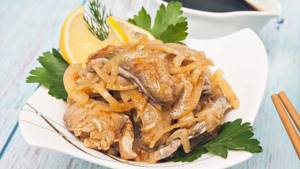
To prepare heh fish according to the Korean recipe you will need:
- fillet – 1 kg;
- 70% vinegar - 2 tbsp. l.;
- salt – 1 tbsp. l.;
- garlic – 4 cloves;
- vegetable oil – 70 ml;
- onions – 4 pcs.;
- soy sauce – 3 tbsp. l. ;
- coriander, paprika, fish seasoning - 1 tsp each.
Cut skinless fillet into 1 cm strips, mix with vinegar and salt, press lightly with a plate. After 20 minutes, the released juice can be drained, add half rings of 2 onions and squeeze out the garlic, mix and cover in the same way.
The dressing for this recipe is prepared as follows:
- fry the half rings of the remaining onions in a frying pan in oil;
- add all spices except soy sauce;
- Remove the heat, cover with a lid and let it brew for 6-7 minutes.
- Pour the dressing and soy sauce into the fish, stir and after 10 minutes, Korean-style heh can be served.
For those who like it a little spicier, we recommend using some hot red pepper in the recipe.
Salted chub
It is advisable to use rice vinegar for this recipe.
Composition of ingredients
To prepare lightly salted chub you will need the following ingredients:
- 2 medium chub carcasses;
- 1.5 tsp. coarse salt;
- 1 tsp. granulated sugar;
- 1 tbsp. l. rice vinegar 3%;
- 1/2 tsp. ground pepper.
Step-by-step cooking process
Chub, fish (photo and description will be of interest to housewives who decided to salt it) is prepared as follows:
- First you need to prepare the chubs. To do this, you need to clean the carcasses of scales with a knife, cut out the insides, cut off the tails with heads, and cut off the fins. Now you can cut the loin along the ridge. Small bones should be removed using tweezers and the fillet should be cut into portions. The skin does not need to be removed.
- Now you can place the chub fillet in a food container. In a small container you will need to mix table salt, ground pepper and granulated sugar. Rub each part of the chub fillet with the resulting mixture, close the container and leave at room temperature for 2 hours.
- When the fillet releases juice, you will need to put the container in the refrigerator for 48 hours. After a day of marinating, you need to pour vinegar over the chub fillet.
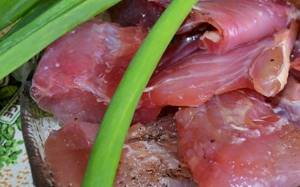
Lightly salted chub should be served with black bread and green onions.
Homemade chub balyk
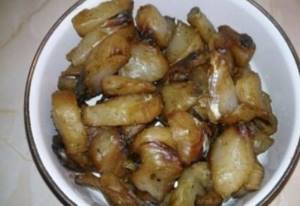
Compound:
- chub – 1 kg;
- coarse salt – 50 g;
- ground black pepper – 5 g;
- hops-suneli or other similar mixture of seasonings - 20 g.
Cooking method:
- Clean and gut a large chub, rinse, and fillet.
- Cut the fish fillets into pieces about 1.5 cm thick. Place in an enamel bowl or container.
- Separately, mix salt with pepper and spicy mixture. Pour into a container with pieces of fish. Mix with your hands. Cover with a plate and place a small weight on top (for example, a liter jar of water).
- Put it in the refrigerator. Salt for 3 days.
- Rinse the fish pieces well, dry them with a kitchen towel, and string them on a thick thread. Hang in a shaded and well-ventilated place for 2 days.
After the specified time, the balyk is ready for consumption. Its taste will certainly not disappoint you.
Read online Chub and asp. All fishing methods page 15. Large and free library
Rice. 14. Balkhash tackle for catching asp: 1 – peg (a loop on the main line is attached to it when baiting the tackle and when removing the caught fish from the hook); 2 – rod, in the split of which the main fishing line is clamped; 3 – main line; 4 – floats; 5 – buoy; 6 – rubber shock absorber; 7 – load.
On the main line, at the point where it is attached to the rubber shock absorber, a foam float is installed, the size and shape of a large lemon. A second similar float is installed a meter from the hook closest to the shore. If there are few hooks installed, then one float, distant, is enough - hooking in this case is more reliable.
The other end of the shock absorber is attached to a sinker (a heavy stone), which, due to the long length of the gear, is not cast from the shore, but launched from a boat (usually a group of fishermen going for night fishing takes with them one single-seater inflatable boat).
The location of the sinker is marked by a white foam buoy attached to it on a fishing line, clearly visible in the dark - so that you can collect the gear after fishing without any hassle. But the weather on Balkhash is changeable, and often the wind gets so strong in just two or three hours that going out into the lake on a tiny inflatable boat is dangerous, even a hundred meters from the shore.
Then, there is nothing to do, you have to try to pull the load by the shock absorber, trying not to tear the rubber. Sometimes it works.
https://www.youtube.com/watch?v=tbsnp40GYKE
Not far from the leash closest to the shore, a large loop is knitted on the main fishing line - when the tackle is selected, it is put on the upper end of a peg driven into the shore not far from the tackle. This eliminates the risk of getting hurt on sharp hooks if a “fool” accidentally released from your hands rushes into a pond.
The bait is small frogs, but it is not always possible to get them, and the original bait is often used, for which the tackle is called a “fool”.
On every third or every fourth hook, a large frog is placed behind the thigh, which the asp cannot swallow, and on the adjacent hooks - a piece of white polypropylene foam the size of a cube of refined sugar.
The frog actively moves, twitching the tackle, the foam propylene also twitches - and attracts asps looking for prey at the surface.
Sometimes the largest asps attack the frog, grabbing it by the paws, so you need to take extra frogs when fishing. Occasionally it is possible to pull out a trophy specimen caught on a frog.
Other fish, besides the asp, are not caught by the “fool”; only once I managed to hook a good pike-perch, which grabbed a frog while pulling out the tackle, near the shore.
Catfish, which abound in Balkhash, for some reason do not pay attention to the frogs fluttering near the surface.
Frogs generally do not like the hot and arid climate of the Balkhash region, and they are collected in a narrow strip (3-4 meters) along the shore of the lake, under flat stones, fragments of boards, etc.
The bite of an asp is felt as a not very energetic tug, and you need to hook it immediately, before the fish understands the deception and spits out the bait. Cases of self-cutting are extremely rare.
The bite signal is a bell, weighted with a lead sinker (the stronger the ripples on the lake, the greater the weight). But more often than not, when the bell rings, it’s too late to strike.
Therefore, next to the peg, to the top of which the main fishing line is tied, they place a simple lighting device: a tin can with a candle stub burning inside and with holes punched in the walls, near the bottom, for air flow.
The jar should be of sufficient height so that the candle flame does not accidentally burn through the selected fishing line when pulling out the asp. The bell is well lit, and as soon as it moves up and forward, they hook it. Sometimes a bite is determined by touch, holding the fishing line in your hand.
Unless flocks of asps suddenly move away from the shores for some reason, which does not happen often, then fishing with a “fool” is extremely productive: usually they stop fishing not because the biting has stopped, but because the total weight of the prey turns out to be unbearable. Although, of course, satiety quickly sets in on such “fish eddorados,” you don’t feel the joy of catching large fish one after another, the capture of which under other circumstances would be remembered for a long time.
Autumn and winter fishing
Many avid poultry fishermen believe that the beginning of autumn, September, is the best time to catch their favorite fish. The asp eats up over the summer, gains weight, and acquires its best fighting and taste qualities. And it bites much more actively - asp bites often occur during the splashdown of the bait, and the bites are so strong that the spinning rod is torn out of your hands...
However, the beginning of autumn is a loose concept; in the southern regions, asps are most successfully caught in October - mid-November. In our north-west, the activity of the asp drops by this time, it concentrates on limited areas of the river, does not demonstrate its famous “fight” and takes well only from time to time.
Fast top-line retrieving is no longer used, and some experienced spinners advise when fishing on fast rivers to suspend the movement of the bait until it stops completely at the border of the stream and calm water, but if a dark spot of grass or a small area of silty bottom on a sandy or clayey rift gets in the way of the spoon , the speed of wiring should be increased; the asp likes to hide in such places in the fall.
Catching on the track is more successful in the fall - having descended into the lower bottom layers of water, asps are less afraid of a floating boat, and the bait can be towed at a shorter distance.
Oddly enough, with the onset of frost, the asp does not slide into deep holes with a slow current (at least not always and not everywhere) - it can often be found on flat sections of the river with a fairly strong current and with a depth of 2–4 meters. Since small fish avoid such places in winter, it remains to conclude: the oxygen regime for the asp in winter is more important than food.
On non-freezing rivers (there are more and more of them in the middle zone due to global warming), asp are pursued even in winter by fans of winter spinning rods (their number is growing for the same reasons).
The range of baits used in winter changes: Devons and wobblers are practically not used, but much more often than in summer, spinners try to seduce asps with jig baits.
But seduction is not so easy: asps stand quite densely at the bottom, using its unevenness as shelter from the force of the current, and feed little, in fits and starts.
Tandems “fly-spoon” and “wabik-spoon” are very popular in winter - the instinct to intercept someone else’s prey can sometimes stir up a sluggish winter asp.
In Central Asia, on the Syr Darya, according to local fishermen, asp are caught in the winter with only one fly, resembling a tassel 5 cm long - it is knitted from thin nylon ribbons on a double hook No. 8.5 (long casts are required and it is included in the equipment instead of a spinner). sinker).
But for some reason I never had the desire to hunt for an asp in knee-deep snow...
Application Chub and asp in the kitchen and on the table
Both asp and chub have one drawback that is common to many carp fish - an abundance of small bones in the meat. The easiest way to get rid of excessive bonyness is to wither or smoke caught fish - salt softens the small bones and they are not felt when eating. But if you want to try more delicious dishes from chub or asp, I advise you to use one of the recipes below.
Balyk from asp
Most successfully, to my taste, the culinary merits of asp are manifested in salted form - balyks from this fish literally melt in the mouth and are not much inferior to those prepared from salmon fish.
For salting, use coarse salt. Its main purpose is to remove moisture from the fish, and not to give it taste or have a preservative effect.
Coarse salt dissolves slowly at low temperatures and requires moisture, which it draws from the fish.
With fine salt this effect does not work; it seems to “burn” the fish meat, quickly salts it, but does not dehydrate it.
Before salting, the asp should be gutted, the head and fins should be removed along with the bases.
Very large fish can even be cut into pieces, but there is no need to touch the abdominal cavity, so as not to damage the thin film covering the layer of fat on the abdomen.
An incision is made through the back, along the ridge, cutting off the ribs from the spine on one side. Fish and fillet pieces are not washed in water, but only wiped dry with a clean cloth.
Salt will soften the small bones that abundantly penetrate the asp meat, and they will not be noticeable in the finished product. But the ribs should be removed - in small fish they are pulled out of the body by holding the base of the rib, cut off from the ridge, between the thumb and a knife. With large specimens you sometimes have to use pliers.
The top of the fish is rubbed with salt, this removes the mucus and, in addition, salt gets clogged under the scales. Salt consumption is 150 grams per kilogram of live weight of the asp.
The taste of the finished fish is better if you mix 1-2 tablespoons of granulated sugar into the prepared salt, but the main thing here is not to over-sweet it.
Spices - optional: some cooks place 2-3 bay leaves and a few aromatic peppercorns in the abdominal cavity of the fish, others deny the need for seasonings.
The salted carcasses are folded with the scales facing out, each is wrapped in several layers of a slightly moistened rag and placed in a prepared container, which should be stored in a cool place - in the cellar, on the bottom shelf of the refrigerator. After a week, the balyk is ready to eat.
Large chubs can also be salted in the same way, but balyks made from them still do not have such a delicate taste as asp ones.
Source: https://dom-knig.com/read_197547-15
Chub baked in parchment
This recipe is suitable for lovers of unusual dishes and delicacies, because not only unusual ingredients are used here, but also the baking method itself is not easy. We will bake the chub in parchment, but not as everyone is used to - in parchment.
Ingredients:
- 8 tsp. unsalted butter;
- 150 g cauliflower;
- 2 tbsp. l. ground garlic;
- salt and pepper to taste;
- 2 tbsp. l. lime juice
- 1 tbsp. l. ground mint;
- 4 chub fillets;
- 1 tsp. curry;
- 16 pea pods.
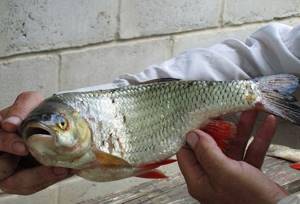
Recipe:
- Preheat the oven to 180 degrees.
- Cut 4 sheets of parchment into hearts. The width of each heart is approximately the width of a roll of parchment. Fold them in the center like valentines, then open them back up. Brush the exposed surface of each heart with 1 teaspoon of the oil, leaving the border untouched.
- Using a very sharp knife, cut the cauliflower into small pieces. Place the cauliflower in a bowl with the garlic or onion and season with salt, pepper, a tablespoon of lime juice and 1 teaspoon of mint. Mix well.
- Place the cauliflower on one side of each heart in a single layer, leaving the border clear. Do not rinse the bowl.
- Place the chub in the bowl with the cauliflower and season with salt, pepper, curry powder and the remaining lime juice. Place carefully to coat each piece with seasonings. Place a piece of chub on top of the cauliflower. Sprinkle with mint and remaining oil (or coconut milk). Place 4 pea pods on each piece of fish.
- Fold the empty heart half over the chub and vegetables, securing the edges with a series of overlapping folds. Start at the rounded end, working your way to the point by twisting it into a ponytail. Tuck your ponytail under your bun.
- Transfer the parchment-wrapped fish to a baking sheet. Bake for 10 minutes or until the fish is cooked through. Let cool 4 minutes. To serve, cut an X into the top of each package. Peel the paper and decorate with mint sprigs or onion flowers.
There are hundreds of recipes on how to deliciously cook chub; here we have presented the most exotic and delicious ones.
You can safely experiment with ingredients, because chub can be combined with many vegetables, side dishes and spices.
In addition, do not forget about the marinade in which you should put the fish before cooking to remove the muddy taste. Dishes using chub will certainly delight you and will then decorate the table.
How to cook chub in marinade
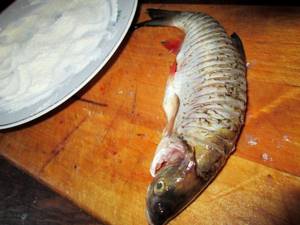
For this dish, you need to make a marinade, to which, in addition to salt, sugar, vinegar, pepper and bay leaf - traditional marinade components, you can add spicy and aromatic herbs and roots, lemon.
Ingredients:
- chub – 2 kg,
- chopped dill - 3 tbsp. l.,
- marinade – 1000ml.
- Ingredients for 1 liter of marinade:
- apple or wine vinegar – 500 ml.,
- water – 400 ml.,
- lemon – 1 pc.,
- onion – 1 pc.,
- sugar – 120 g,
- salt – 90 g,
- peppercorns – 5 pcs.,
- grated horseradish – 1 tbsp. l.,
- grated ginger – 1 tbsp. l.,
- carrots -50 g,
- bay leaf – 2 pcs.,
- mustard seed – 20 g,
- juniper berries – 5 pcs.
Cooking method:
- Grate the horseradish and ginger, cut the carrots into slices. Squeeze the juice out of the lemon.
- Place all marinade components in a saucepan and add water. Put on fire, when the contents boil, pour in vinegar and lemon juice. Bring the marinade to a boil, keep on fire for 1 minute, turn off and cool.
- Prepare the chub: remove scales, rinse, gut and remove gills. Rinse again under running water and cut into pieces 4-5 cm thick.
- Place the fish in a porcelain, glass or enamel bowl, sprinkle the pieces with dill, pour over the marinade, cover with a lid and put in the refrigerator.
- The fish will marinate and be ready in 3-4 days.
If there is any marinade left, you can pour it into a bottle and store it in the refrigerator.
Fried ide with sour cream and onions
Fish fried in sour cream is a typical dish for Russian cuisine. Sour cream adds tenderness and makes lean fish fattier and tastier. When frying in sour cream, you can use an egg instead of breading; it will prevent the fish from drying out.
Ingredients:
- ide – 1200-1300 g,
- onion – 150 g,
- sour cream – 150 ml.,
- bread crumbs – 120 g,
- vegetable oil – 100 ml.,
- lemon juice – 70 ml.,
- salt, black pepper
How to fry ide with onions and sour cream:
1. Prepare the fish in the usual way, cleaning it from scales, removing gills, fins and entrails. Rinse the carcass well under running water and soak for an hour and a half in salt water to get rid of the unwanted smell of mud. 2. Remove the ide from the salty “bath”, rinse under running tap, dry with paper towels and cut into pieces suitable for one serving, about four centimeters. Thicker pieces will take a long time to fry, while smaller pieces may fall apart during cooking. 3. Lightly salt the fish (it has already absorbed a little salt when soaking), pepper and roll in breadcrumbs. 4. Heat a frying pan with vegetable oil well and place pieces of ide on it. Fry on both sides until crispy: on one side for 10-12 minutes, on the other - 7 minutes. 5. Cut the peeled onion into half rings and add to the frying pan with the fish. Continue frying for another 3-4 minutes. 6. Distribute the sour cream evenly over the fish, cover with a lid, after 2-3 minutes, when the sour cream begins to curdle, turn off the burner, but keep under the lid for another five minutes, after which you can serve, placing it on a dish.
If the fish is small, then you can not cut it into portioned pieces, but fry it whole, making small longitudinal or slightly diagonal cuts.
Chub baked in the oven

Chub is a very popular river fish; it is often used to make fish soup. If you have a large chub in your kitchen, I advise you to cook it in the oven. It turns out incredibly tasty and retains its beneficial properties to the maximum.
To prepare the dish we will need the following ingredients:
- one large chub - 500-700 g;
- parsley - 1 bunch;
- bulbs - 2 pcs.;
- several laurel leaves;
- sour cream - 150 g;
- paprika, salt, allspice, vegetable seasoning.
